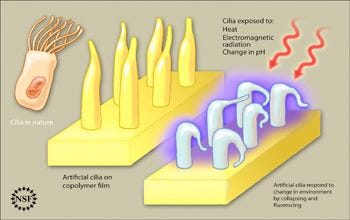Artificial Cilia Could Revolutionize Sensor Technology
September 30, 2010
|
Newly engineered artificial cilia that respond to changes in heat, electromagnetic radiation, and acidity could eventually form the basis of medical device sensors used in such applications as glucose monitors. (Image by Zina Deretsky, National Science Foundation.) |
Scientists at the University of Southern Mississippi (Southern Miss; Hattiesburg) have developed a thin molecule-based material that resembles cilia, the tiny, wavy, hairlike structures that protrude from organs and through which organisms derive smell, vision, hearing, and fluid flow. While the new material isn't exactly like cilia, it responds to thermal, chemical, and electromagnetic stimulation, enabling researchers to control and perhaps wield it for a range of future applications, including medical device ones.
Supported by the division of materials research at the National Science Foundation (Arlington,VA), the scientists at the Materials Research Science and Engineering Center for Response-Driven Polymeric Materials at Southern Miss created a thin copolymer film featuring whisker-like formations that mimics Mother Nature.
Employing a process used for years to produce latex paints, the researchers formed thin copolymer-based films with a chemical composition that enables them to produce filaments with built-in molecular sensors. These sensors, in turn, can respond to temperature, acidity, and ultraviolet radiation. Moreover, the filaments are capable of locomotion, waving, shrinking, and expanding in response to stimuli. They also are capable of fluorescence, enabling them to absorb and emit light and changing colors in response to ultraviolet rays.
"Our interest is in developing materials with multilevel responses at various length and time scales," remarks Marek Urban, professor of polymer science and engineering. "I believe this is the future of science and engineering that will drive future technologies."
In addition to performing a variety of sensing operations in environmental applications, the new cilia may one day find their way into sensors used for testing glucose levels. There is no limit to dreaming up applications for such a material, Urban says. "Many new ideas are being generated as we speak, but it is too early to reveal them."
The research is presented in "Advanced Functional Materials: Colloidal Films That Mimic Cilia," published in the journal Advanced Functional Materials.
About the Author(s)
You May Also Like


.png?width=300&auto=webp&quality=80&disable=upscale)
